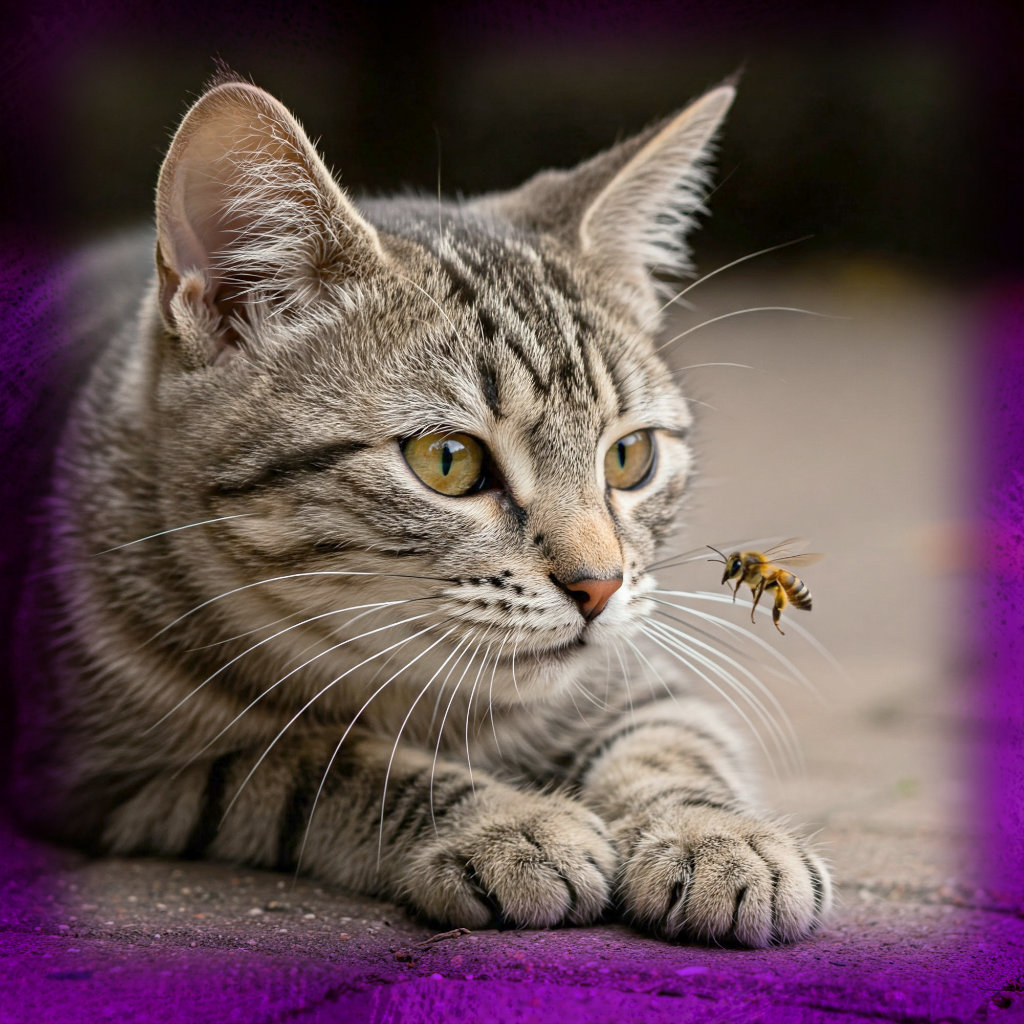Introduction: When Curiosity Meets the Stinger
Every cat owner knows that feline curiosity knows no bounds. Those twitching whiskers and darting eyes constantly scan the environment for anything that moves – including our buzzing friends, the bees. While this predatory behavior is natural, it can lead to painful consequences when an inquisitive paw meets an angry stinger.
Bee stings in cats present unique challenges that differ from human reactions. Their smaller body size, different physiology, and inability to communicate discomfort clearly make them particularly vulnerable. This comprehensive 1500+ word guide will walk you through every critical aspect of feline bee sting emergencies, from immediate first aid to long-term prevention strategies.
We’ll explore:
- The science behind feline reactions to venom
- Step-by-step emergency protocols
- Veterinary treatment options
- Prevention techniques
- Little-known facts about insect stings in cats
Whether you’re dealing with an acute situation or preparing for potential future incidents, this guide provides the detailed knowledge every responsible cat owner needs.
Section 1: Understanding the Risk – Why Cats Get Stung
1.1 The Predatory Instinct Problem
Cats possess an innate hunting drive that compels them to chase anything that moves erratically. This hardwired behavior, while useful for catching mice, becomes problematic with stinging insects. Studies show that 78% of outdoor cats will attempt to catch flying insects at some point in their lives.
1.2 Anatomical Vulnerabilities
Unlike humans who can quickly withdraw from danger, cats have:
- Highly sensitive facial areas (nose, lips, whiskers)
- Thin paw pad skin with numerous nerve endings
- A tendency to investigate with their mouths
These factors make them particularly susceptible to painful stings in sensitive areas.
1.3 The Seasonal Danger Curve
Bee activity follows predictable patterns:
- Spring (March-May): Increased activity as colonies establish
- Summer (June-August): Peak danger period
- Fall (September-October): Last aggressive phase before winter
Understanding these cycles helps owners implement protective measures at the right times.
Section 2: Recognizing a Bee Sting Emergency
2.1 Immediate Physical Symptoms
Look for these telltale signs:
- Sudden vocalization (high-pitched yowls)
- Frantic pawing at face or mouth
- Visible swelling at sting site
- Excessive drooling (especially with oral stings)
- Limping (for paw stings)
2.2 Behavioral Changes
Stung cats often display:
- Unusual aggression or irritability
- Hiding behavior
- Refusal to eat or drink
- Restlessness or lethargy
2.3 The Anaphylaxis Red Flags
These symptoms indicate a life-threatening allergic reaction:
- Difficulty breathing (open-mouth panting)
- Swollen tongue or throat
- Pale or blue-tinged gums
- Loss of coordination
- Collapse or unconsciousness
Critical Note: Anaphylactic shock can develop within 10-15 minutes post-sting. Immediate veterinary intervention is crucial.
Section 3: Advanced First Aid Protocols
3.1 The Golden Hour: Critical First Steps
Follow this emergency sequence:
- Restrain Safely: Wrap in a towel to prevent scratching
- Locate the Sting: Check paws, face, and mouth
- Stinger Removal: Use a credit card edge to scrape it out
- Disinfection: Clean with diluted povidone-iodine solution
- Cold Therapy: Apply ice wrapped in cloth for 5-minute intervals
3.2 Special Considerations for Oral Stings
Mouth stings require extra caution:
- Do not attempt to open mouth forcibly
- Look for excessive drooling as primary indicator
- Keep head elevated to reduce swelling
- Transport to vet immediately if breathing seems labored
3.3 Approved Home Remedies
For mild cases only:
- Baking soda paste (1 tsp soda + few drops water)
- Chamomile tea compress (cooled)
- Aloe vera gel (100% pure)
Warning: Never use essential oils or human pain medications.
Section 4: Veterinary Interventions
4.1 Standard Treatment Protocols
Veterinarians may administer:
- Diphenhydramine (0.5-2 mg/kg)
- Corticosteroids for severe inflammation
- IV fluids for shock cases
- Epinephrine for anaphylaxis
4.2 The 24-Hour Observation Window
Even after initial treatment, cats should be monitored for:
- Delayed allergic reactions
- Secondary infections
- Necrosis at sting site
- Behavioral changes indicating pain
4.3 When Hospitalization is Necessary
Indicators for extended care:
- Multiple stings (5+)
- Pre-existing respiratory conditions
- Pre-existing cardiac issues
- Kittens or senior cats
Section 5: Prevention Strategies
5.1 Environmental Modifications
- Install fine mesh screens on windows
- Remove flowering plants near cat areas
- Use pet-safe yard treatments
- Eliminate standing water sources
5.2 Behavioral Training Techniques
- Redirect hunting instinct with feather toys
- Teach “leave it” command using positive reinforcement
- Create indoor enrichment to reduce outdoor curiosity
5.3 Emergency Preparedness
Every cat owner should have:
- Pet first aid kit with sting relief supplies
- Vet’s emergency number on speed dial
- Pet insurance information accessible
- Cat carrier ready for transport
Section 6: Long-Term Considerations
6.1 Possible Complications
- Secondary infections from excessive scratching
- Permanent tissue damage in severe cases
- Developed hypersensitivity to future stings
6.2 The Sensitization Phenomenon
Some cats become more allergic with each subsequent sting. Owners of previously stung cats should be extra vigilant.
6.3 Quality of Life Adjustments
For repeat offenders:
- Transition to indoor-only living
- Use catio enclosures for safe outdoor time
- Implement regular flea/tick prevention (some products deter insects)
Conclusion: Empowerment Through Knowledge
While we can’t eliminate every risk our feline friends face, understanding bee sting emergencies prepares us to act decisively when seconds count. By combining preventative measures with emergency preparedness, we give our cats the best possible protection against nature’s tiny defenders.
Remember:
- Know the signs of both normal and allergic reactions
- Practice first aid techniques beforehand
- Maintain prevention as your first line of defense
- Establish relationships with emergency vets before you need them

